Art Bridgman and Myrna Packer present the New York premieres of two works.
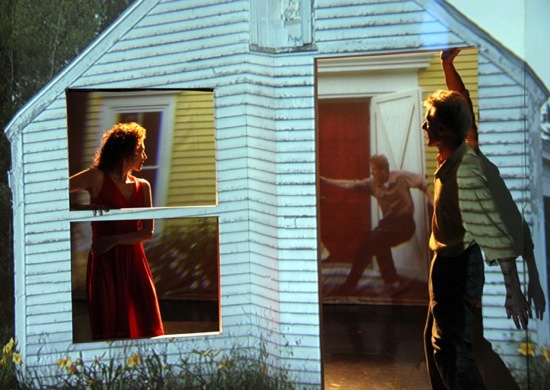
Myrna Packer and Art Bridgman(s) in their Voyeur. Photo: Tyler Silver
One source of theater’s magic lies in the interplay between what’s real and what’s not. An actor who is not actually the “Tom” of the play bids his wife “Susan” goodbye and walks out the door. It looks like a real door, but there’s no street out there, only dressing rooms and backstage equipment. We accept that a woman in pointe shoes and a tutu isn’t a woman but a swan who was once a woman, even though she neither flies nor swims. Our hearts beat faster when a black-and-white, two-dimensional image of a man who both is and is not Humphrey Bogart looks into the eyes of a filmed woman who is and is not Ingrid Bergman. Shadow puppets, hand puppets, and marionettes begin as objects; strings, two human hands, and a human voice bring the doll dressed as Red Riding Hood to life. The wolf menacing her is being manipulated by a second unseen puppeteer who is standing companionably beside the puppeteer handling the little girl and trying not to get his/her strings tangled with those of her/his colleague.
I could go on. But then I’d never get to the business at hand: two works by Bridgman / Packer Dance that received their New York premieres at the Sheen Center’s Loreto Theater in Soho. For years, Art Bridgman and Myrna Packer (husband and wife as well as artistic collaborators) have been performing all over the world alongside life-sized filmed images of themselves. Inevitably, their topics tend to be dreams, memories, visions, alter egos, paranoid delusions—whatever renders believable their encounters with themselves. Their finest illusions raise haunting questions about perception and reality, about shifting perspectives of time and space, and about human relations. Their less penetrating ones—no less exciting visually—are those that seem less rooted to their theme and more oriented toward display (perhaps because the theme is a complex one).
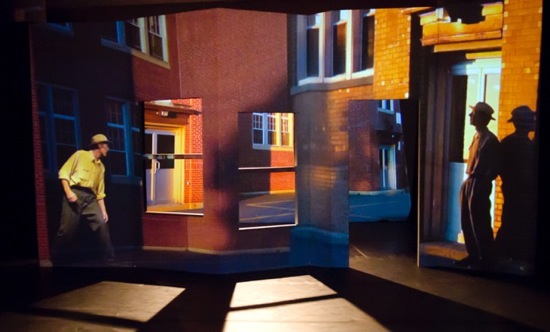
Art Bridgman and his other self in Bridgman / Packer Dance’s Voyeur. Photo: Arthur Fink
I think this is why I found their Voyeur (2012) (last on the program) more engrossing than their Remembering What Never Happened (2015). Voyeur provides shifting visions of a single resonant topic; at first Bridgman is a voyeur, but we become ones too, even though what we see is not controlled by us. During intermission, stagehands set up and join the tall white panels in an irregular accordion-ish formation. There are three actual framed openings in them. The placement of the set is crucial, since it receives projections (video by Peter Bobrow). I didn’t join the audience members who lined up to walk through the installation in small groups, instead watching them disappear, reappear, and react to both the actual space and the virtual one from inside it.
The sound of train wheels ushers in the first image. The scene that transforms the white panels is the exterior of a building. Packer hangs a dress near a windowsill, disappears from our sight, and reappears in a red dress. Behind her in the city structure is a projected doorway that shortly reveals her virtual double in a bare room. Bridgman’s image tracks her through a vista of empty halls. She pauses to pull up her skirt and stroke her leg, as if smoothing a stocking. Suddenly the building is a red brick one on a deserted street, where the real Bridgman, wearing a hat, loiters watchfully. Her image appears in front of the same building. His own image confronts him and merges with him.
The program tells us that Voyeur was inspired by the paintings of Edward Hopper, and I can see that. The clean-lined, unshadowed buildings, a man alone in a room or looking into the lit window of a restaurant. The sound design by Scott Lehrer and Leon Rothenberg includes music by Robert Een and by Cab Calloway.
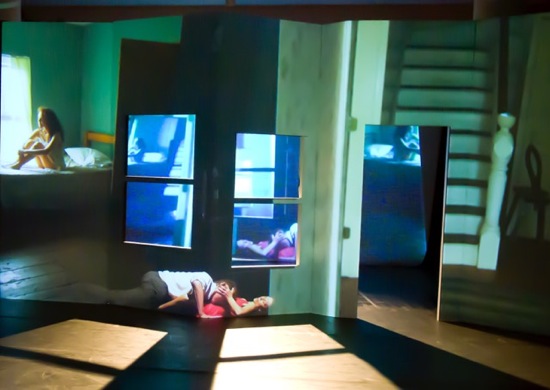
Myrna Packer and Art Bridgman in Voyeur, alone and together simultaneously. Photo: Arthur Fink
Over the course of the work, the scene changes; now it’s a shabby white clapboard house; now it’s a red barn; now a yellow cottage, Intermittently a bedroom appears within it, with Packer tossing in the bed and, later, with the two of them in or on that bed. Wherever they appear, Bridgman is sneaky, and Packer alert. He favors a wide-legged, bent-kneed stance and, within that moves tempestuously—pausing or freezing often, in order to remain in synch with the changing locations. Sometimes the flesh-and-blood performers meet. He fondles a strand of her red hair between his fingers. He strokes her face. Once he pulls a dress over her head and puts his arms around her.
Wherever she goes, he is watching her, and she knows it. Their multiplying images suggest travel, but also instability. She may think she glimpses him, but was he “really” there? At one point, they seem to be chasing each other. Suddenly there’s no house, only ocean. We are the real voyeurs—peering through windows, catching reflections in a mirror—wondering who these people are.
The air of hyper-alertness and the pause-studded rhythms are crucial to the style of Remembering What Never Happened as well. In this case, the two characters’ recollections lead them into a variety of situations and place, their intermittent recorded voices helping us to understand the conflicting nature of their memories. Bridgman and Packer (such winning performers!) created not only the choreography, but the videos, and the eight musical selections differ greatly from one another (John Guth, also the sound designer; Etta Baker; and Maurice Ravel are some of the names listed in the program).
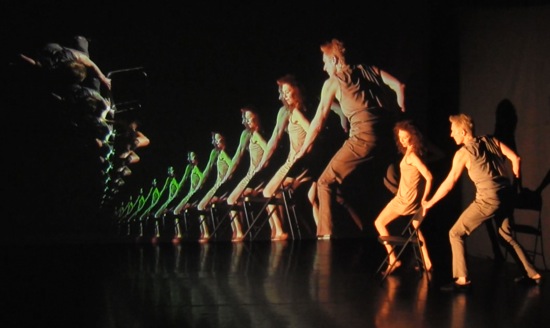
Art Bridgman and Myrna Packer in their Remembering What Never Happened. Photo courtesy of Bridgman / Packer Dance
Here you never know for sure where the dancers and/or their images will appear. One of the settings is a gray, rocky cliff, before which they can move, and out of its cracks their alter egos can materialize. Packer, alone, dances in canon with her identically dressed images. And both she and Bridgman also acquire strange other selves that cluster around them; these are fragmentary black-and-white outlines that look as if they’d been drawn in chalk—as frail and colorless as some memories. The work’s process, like that of Voyeur, combines live camera, video processing, and pre-recorded footage (lighting design by Frank DenDanto III, technology design by Phillip Gulley). In this case, multiple images sometimes blend into a pattern, within which the performers’ doppelgängers are hardly visible as such.
At one point, Bridgman sits on a chair, and a train of successively smaller images of him curls across the stage’s backdrop; when Packer sits on his lap, and they move on and off the chair, the serpentine effect becomes even more complex. Another effect: He turns his back to us and moves minimally; a tiny image of her appears in motion on his white tee shirt. Although differing perspectives are the key to this work, a few of them don’t immediately relate to the idea of their disparate realities (unless you think really hard)—for instance, Packer on the floor, “swimming,” shot from overhead.
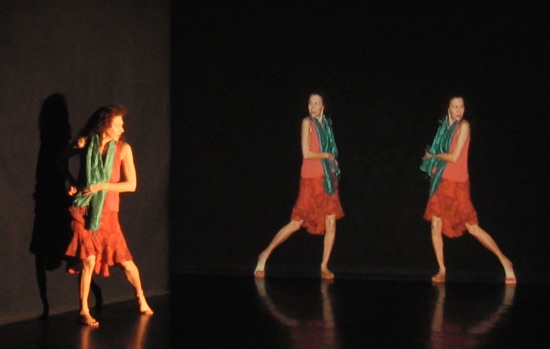
Myrna Packer (L) and selves in Remembering What Never Happened. Photo courtesy of Bridgman / Packer Dance
In the end, both are dressed differently (he in a jacket, she in a dress), and they have a great time dancing together, while the images at the back go crazy. The last words are “That’s not how I remember it.”
There’s a moment in Remembering What Never Happened that feels like an ending. Packer, lying down, seems to sink into the rocks beneath her and disappear, with Bridgman hovering over her. But obviously that wasn’t the note the two of them wanted to end on. So the dancing surges up again—the happy moments of contact, the multiplying images, the voices, the amazing effects. And the work begins to seem long. However, once Bridgman and Packer have finished a piece, editing is almost impossible. And, for sure, the surging and fading collage of recollections mimics some of those periods in our own lives when we sift through our mementos, unable to bear parting with any of them.

Mindy Aloff, via e-mail, has pointed out an error that occurred in the first paragraph of my review of Bridgman Packer Dance: “We accept that a woman in pointe shoes and a tutu isn’t a woman but a swan who was once a woman, even though she neither flies nor swims.” I was, of course, referring to Swan Lake. As Aloff rightly notes, the enchanted heroine of the ballet and her comrades are swans by day (the fake birds swimming by in the background makes that clear), but maidens by night. Prince Siegfried is not attempting to court a bird.
However, everything hinted at by Odette’s feathery headdress and birdlike flutterings, as well as by her companions’ tendency to flock, suggests that Von Rothbart’s spell worked some pretty deep magic on her soul. As George Balanchine and Francis Mason say of Siegfried in Balanchine’s Stories of the Great Ballets, “He cannot believe his eyes, for the girl appears to be both swan and woman.” So my point about Odette, although played by a woman, not being a woman is technically incorrect, and neither is she a full-fledged swan. In her dancing, those two identities poetically merge.